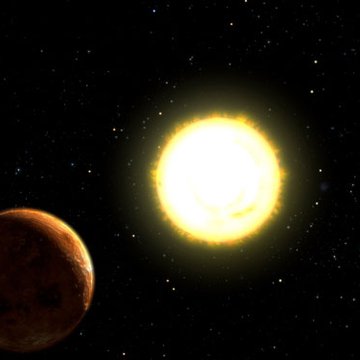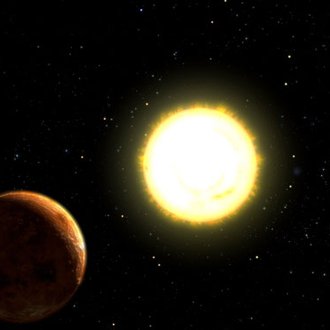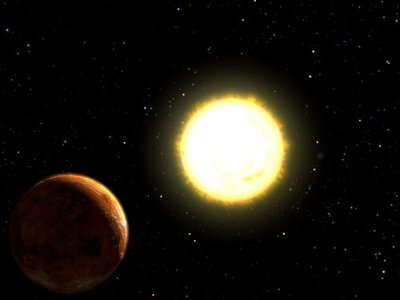New conditions for life on other planets
Tidal effects change the concept of the habitable zone.
Tides can render the so-called “habitable zone” around low-mass stars inhabitable. This is the main result of a recently published study by a team of astronomers led by René Heller of the Astrophysical Institute Potsdam (AIP).
Extrasolar planets, or exoplanets for short, have been known to exist outside our solar system since 1995. When searching for life in outer space, scientists focus on those exoplanets that are located in the habitable zone. This means that they orbit their sun at a distance where the temperatures on the planet’s surface allow for the presence of liquid water. Water is believed to be an essential ingredient for life. Until now, the two main drivers thought to determine a planet’s temperature were the distance to the central star and the composition of the planet’s atmosphere. By studying the tides caused by low-mass stars on their potential Earth-like companions, Heller and his colleagues have concluded that tidal effects modify the traditional concept of the habitable zone.
Heller deduced this from three different effects. Firstly, tides can cause the axis of a planet´s rotation to become perpendicular to its orbit in just a few million years. In comparison, the Earth’s axis of rotation is inclined by 23.5 degrees – an effect which causes our seasons. Owing to this effect, there would be no seasonal variation on such Earth-like planets in the habitable zone of low-mass stars. These planets would have huge temperature differences between their poles, which would be in perpetual deep freeze, and their hot equators which in the long run would evaporate any atmosphere. This temperature difference would cause extreme winds and storms.
The second effect of these tides would be to heat up the exoplanet, similar to the tidal heating of Io, a moon of Jupiter that shows global vulcanism.
Finally, tides can cause the rotational period of the planet (the planet’s “day”) to synchronize with the orbital period (the planet’s “year”). This situation is identical to the Earth-moon setup: the moon only shows the Earth one face, the other side being known as “the dark side of the moon”. As a result one half of the exoplanet receives extreme radiation from the star while the other half freezes in eternal darkness.
The habitable zone around low-mass stars is therefore not very comfortable – it may even be inhabitable. From an observer’s point of view, low-mass stars have so far been the most promising candidates for habitable exoplanets. Now, due to Heller’s findings, Earth-like exoplanets that have already been found in the conventional habitable zone of low-mass stars, have to be re-examined to consider tidal effects.
Heller and his colleagues have applied their theory to GI581g: an exoplanet candidate that has recently been claimed to be habitable. They find that GI581g should not experience any seasons and that its day is synchronized with its year. There probably would be no water on the planet’s surface, rendering it inhabitable.
Heller: “I think that the chances for life existing on exoplanets in the traditional habitable zone around low-mass stars are pretty bleak, when considering tidal effects. If you want to find a second Earth, it seems, you need to look for a second Sun.”
Further information
Original publication
R. Heller, J. Leconte and R. Barnes, Tidal obliquity evolution of potentially habitable planets, Astronomy & Astrophysics 528, A27 (2011).
Tidal effects change the concept of the habitable zone.
Tides can render the so-called “habitable zone” around low-mass stars inhabitable. This is the main result of a recently published study by a team of astronomers led by René Heller of the Astrophysical Institute Potsdam (AIP).
Extrasolar planets, or exoplanets for short, have been known to exist outside our solar system since 1995. When searching for life in outer space, scientists focus on those exoplanets that are located in the habitable zone. This means that they orbit their sun at a distance where the temperatures on the planet’s surface allow for the presence of liquid water. Water is believed to be an essential ingredient for life. Until now, the two main drivers thought to determine a planet’s temperature were the distance to the central star and the composition of the planet’s atmosphere. By studying the tides caused by low-mass stars on their potential Earth-like companions, Heller and his colleagues have concluded that tidal effects modify the traditional concept of the habitable zone.
Heller deduced this from three different effects. Firstly, tides can cause the axis of a planet´s rotation to become perpendicular to its orbit in just a few million years. In comparison, the Earth’s axis of rotation is inclined by 23.5 degrees – an effect which causes our seasons. Owing to this effect, there would be no seasonal variation on such Earth-like planets in the habitable zone of low-mass stars. These planets would have huge temperature differences between their poles, which would be in perpetual deep freeze, and their hot equators which in the long run would evaporate any atmosphere. This temperature difference would cause extreme winds and storms.
The second effect of these tides would be to heat up the exoplanet, similar to the tidal heating of Io, a moon of Jupiter that shows global vulcanism.
Finally, tides can cause the rotational period of the planet (the planet’s “day”) to synchronize with the orbital period (the planet’s “year”). This situation is identical to the Earth-moon setup: the moon only shows the Earth one face, the other side being known as “the dark side of the moon”. As a result one half of the exoplanet receives extreme radiation from the star while the other half freezes in eternal darkness.
The habitable zone around low-mass stars is therefore not very comfortable – it may even be inhabitable. From an observer’s point of view, low-mass stars have so far been the most promising candidates for habitable exoplanets. Now, due to Heller’s findings, Earth-like exoplanets that have already been found in the conventional habitable zone of low-mass stars, have to be re-examined to consider tidal effects.
Heller and his colleagues have applied their theory to GI581g: an exoplanet candidate that has recently been claimed to be habitable. They find that GI581g should not experience any seasons and that its day is synchronized with its year. There probably would be no water on the planet’s surface, rendering it inhabitable.
Heller: “I think that the chances for life existing on exoplanets in the traditional habitable zone around low-mass stars are pretty bleak, when considering tidal effects. If you want to find a second Earth, it seems, you need to look for a second Sun.”
Further information
Original publication
R. Heller, J. Leconte and R. Barnes, Tidal obliquity evolution of potentially habitable planets, Astronomy & Astrophysics 528, A27 (2011).
Images
An exomoon circles a gas-giant planet in this artist's impression.





